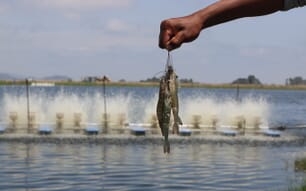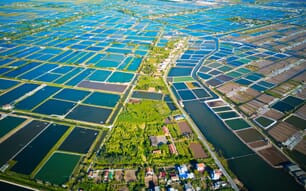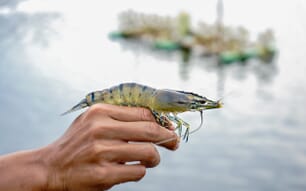
© Sander Visch
When I entered the world of shrimp seven years ago, my first mission was to visit Bangladesh. Studying the cost of production and visiting farms and processors immersed me in the country’s extensive shrimp production system and the people behind it.
Even though my work now largely focuses on vannamei dynamics, I always follow the trends in Bangladesh and their monodon (known locally as bagda) production. During my visit in 2017, Bangladesh was still one of the leading monodon exporters to the EU. However, year after year the country has seen a reduction in its competitive edge in the global monodon shrimp market.
With the apparent decline in competitiveness and export performance, the production volume has decreased from 70,000 tonnes in 2018 an estimated 40,000 tonnes or so in 2024.
The volumes we calculate are usually lower than those reported by either FAO or the Bangladeshi government. The official numbers suggest an almost stable annual output of around 68,000 tonnes since 2013. However, given the market dynamics – both on domestic and export levels – and anecdotal evidence we believe that our numbers provide a more accurate picture of the state of the industry.
Bangladesh's market share in monodon remained around 25 percent during the first six months of 2022 but fell to under 20 percent as global sales rose to 122,000 tonnes live shrimp equivalent (LSE) in 2023, up from approximately 100,000 tonnes in 2019. The main contributor to this growth was India, which surpassed Bangladesh's export volume for the first time in years.
Export performance of Bangladesh
During 2022, exports from Bangladesh rose from June onwards, driven by the positive global market demand after Covid-19. However, exports during 2023 declined by 5 percent and in Q1 of this year the figure was 34 lower than the same period in 2023.
Price competitiveness
Over the years, prices for monodon have experienced a general decline, primarily attributed to the competitive presence of vannamei in the market. At the beginning of 2023, when the price point from India was relatively low, buyers switched to purchasing monodon there. After that, prices from Bangladesh also dropped, enabling some buyers to return to Bangladeshi suppliers again. This was also apparent in October and November, when volumes grew again compared to 2022. Despite these dynamics, when comparing shrimp prices between Bangladesh, India and Indonesia, Bangladesh consistently maintains higher ones.
Comparing these prices, it should be noted that certain importers often ask for more “competitive pricing” for their products. In layman's terms, this means processors and exporters sometimes revert to overglazing and soaking the shrimp during processing, essentially selling shrimp bulked out by water. While the majority of the sector might not practise this, it is thought to be commonplace.
Only Vietnam obtains a higher average price for its monodon, as they supply the high-end market in Japan as well as in other Asian markets. A significant contributor to this is the quality of the end product, which is widely seen as being superior to Bangladeshi monodon. Partly due to the soaking and glazing methods, but also because of the complex supply chain in Bangladesh, where there are multiple ownership exchanges between farms and factories, with only a handful of processors or exporters directly engaging with farmers. This intricate system poses challenges not only in maintaining shrimp quality but also in ensuring its traceability.
Another significant challenge for Bangladesh is posed by the diversified product offerings of shrimp exporters in India and Indonesia. Unlike their Bangladeshi counterparts, exporters from these countries often offer a range of shrimp products, providing them greater flexibility in fulfilling orders or containers. This versatility allows them to compete more aggressively on pricing and explains why efforts are now being made in Bangladesh to invest in vannamei production.
Despite some challenges, a crucial aspect contributing to Bangladesh's resilience in shrimp pricing is the longstanding relationships established by its exporters with importers, particularly in the European Union (EU) and UK. These relationships, built on trust, reliability and consistent quality over time, have played a pivotal role in sustaining comparatively high prices for Bangladeshi monodon. Importers, driven by loyalty to their established suppliers, may be willing to pay premium prices for Bangladeshi shrimp, irrespective of fluctuating spot market prices. This loyalty reduces exporters' dependence on volatile market conditions, enabling them to maintain stable and higher price levels.

© Sander Visch
A big advantage for Bangladesh in the European market is that the country benefits from the EU’s Generalised Scheme of Preferences Plus (GSP+) status, which gives certain developing countries a special incentive to pursue sustainable development and good governance. Eligible countries have to implement 27 international conventions on human rights, labour rights, the environment and good governance. In return, the EU cuts its import duties to zero. As a result, Bangladeshi shrimp is fairly competitive on the European market, especially in the middle sizes (16/20 up to 36/40 counts). However, Bangladeshi exporters can only offer a limited volume of larger sizes, as their extensive production systems cannot produce these sizes. As a result, exporters can only source larger sized shrimp from a limited number of semi-intensive farms.
The recent surge in India's black tiger shrimp exports signals both challenges and opportunities for Bangladesh's shrimp industry. While this shift may initially seem detrimental, there's a silver lining. India's redirection of its increased output towards emerging markets like China and Japan presents a unique opportunity for collaboration and regional growth. By collectively promoting South Asian tiger shrimp in these lucrative markets, Bangladesh, could benefit from heightened demand and expanded market access.
Outlook on the export performance of Bangladesh
It is clear that Bangladeshi exporters face significant hurdles in accessing end markets and prioritising traceability, quality and sustainability certification. While previously this was primarily stipulated by EU retailers, the continent’s food service sector has also increasingly adopted these requirements.
As a result, there have been attempts to push for Aquaculture Stewardship Council (ASC) certification. However, while the first ASC-certified Bangladeshi shrimp were expected to be on the market in 2020, Covid-19 and other issues have slowed the process down. To improve market access, these Aquaculture Improvement Projects (AIPs) enable small-scale operators to adopt the right practices to obtain ASC certification. One such initiative is led by Luna shrimp farms, which are owned and operated by the large-scale monodon exporter and importer Lenk.
By fostering direct engagement with farmers, processors could significantly improve the quality of the shrimp. Additionally, enhanced traceability measures could help meet the stringent standards required by international markets, particularly in the EU, where retailers and the food service sector demand high levels of transparency and accountability.
Given the extensive farming methods used in Bangladesh, with minimal use of industrial feeds, and low energy consumption, Bangladeshi shrimp could also help retailers and wholesalers reach their climate ambitions.
According to IDH, which organised an Aquaculture Working Group on Environmental Footprint, extensive production of tiger shrimp could help seafood businesses to reduce their CO2e levels. However, it’s up to the exporters to start collecting data to back up this claim if they want to capitalise on this unique selling point in an ever-more demanding market.








